
Potentilla is a genus containing over 500 species of annual, biennial and perennial herbaceous flowering plants in the rose family, Rosaceae.

Pyrgus malvae, the grizzled skipper, is a butterfly species from the family Hesperiidae. It is a small skipper (butterfly) with a chequered pattern on its wings that appears to be black and white. This butterfly can be found throughout Europe and is common in central and southern regions of England. The butterfly prefers three major types of habitat: woodland, grassland, and industrial. Referenced as a superspecies, Pyrgus malvae includes three semispecies: malvae, malvoides, and melotis. Eggs are laid on plants that will provide warmth and proper nutrition for development. As larvae, their movement is usually restricted to a single plant, on which they will build tents, unless they move onto a second host plant. Larvae then spin cocoons, usually on the last host plant they have occupied, where they remain until spring. Upon emerging as adult butterflies, grizzled skippers are quite active during the day and tend to favour blue or violet-coloured plants for food. They also possess multiple methods of communication; for example, vibrations are used to communicate with ants, and chemical secretions play a role in mating. Exhibiting territorial behaviour, males apply perching and patrolling strategies to mate with a desired female.
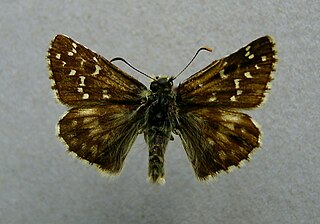
The Large Grizzled skipper is a species of skipper butterfly.
Pyrgus warrenensis, the Warren's skipper, is a species of skipper. It is a strictly Alpine species.

Oberthür's grizzled skipper is a species of skipper.

Foulquier's grizzled skipper is a species of skipper. It has a limited distribution in central and southern France and adjacent areas of Spain and Italy and also Corsica. Within this range it can be quite common.

The carline skipper is a butterfly and a species of the skipper. It is a montane butterfly only found in southwestern areas of the Alps. It can be an abundant species within this restricted range.

The Cinquefoil Skipper is a species of skipper butterfly.
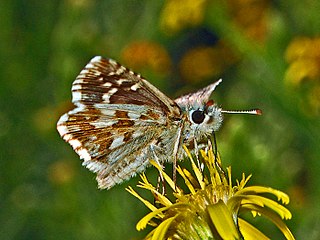
The rosy grizzled skipper is a species of skipper.
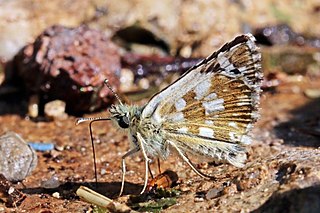
The sandy grizzled skipper is a species of skipper. It has a restricted range in southeastern Europe with a small relict population in central Spain.

Spialia sertorius, commonly known as the red-underwing skipper, is a butterfly of the family Hesperiidae.

Carcharodus alceae, commnly known as the mallow skipper, is a species of butterfly of the family Hesperiidae.

The safflower skipper is a species of skipper butterfly.

The Alpine Grizzled Skipper is a species of skipper.
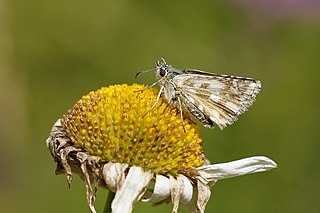
The Dusky Grizzled Skipper is a species of skipper butterfly.
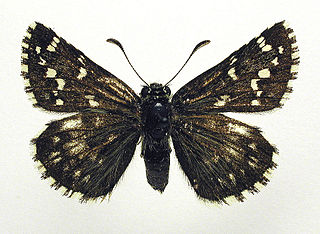
The northern grizzled skipper is a Holarctic species of skipper butterfly with a range in North America from the subarctic to the north, New Mexico to the south, and the Appalachian Mountains to the east.In the Palearctic the species which was described from Norway is distributed across Scandinavia and the northern part of European Russia across the Urals through northern Asia to the Altai.

Oeneis glacialis, the Alpine Grayling, is a butterfly of the family Nymphalidae. It is found in the Alps at heights of 1400 to 2900 m above sea level.

Muschampia floccifera, the tufted skipper or tufted marbled skipper, is a butterfly of the family Hesperiidae.

Pyrgus malvoides, the Southern Grizzled Skipper, is a species of skipper.
Pyrgus centaureae wyandot, the Appalachian grizzled skipper, is a small, brown, gray and white butterfly known to inhabit parts of the Appalachian highlands and Northern Michigan. It can be identified by its characteristic checkered wing pattern formed by the scales on the fore- and hindwings. The butterflies are known to prefer sites with minimal vegetation, such as open areas in hardwood forests, as well as sites of recent disturbance. The skipper's main larval food plants include Canada cinquefoil and wild strawberry depending on the specific population's range. The butterfly is listed as a federal species of concern and holds a state endangered title in Ohio and New Jersey.



















